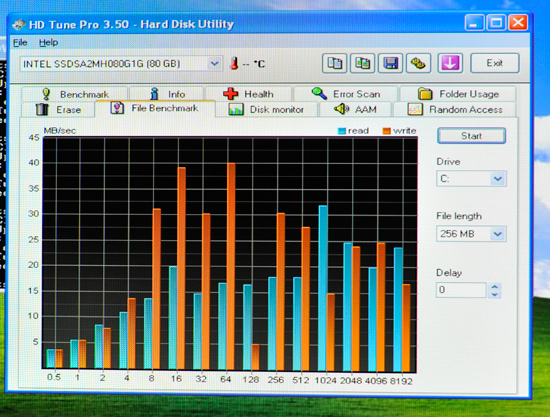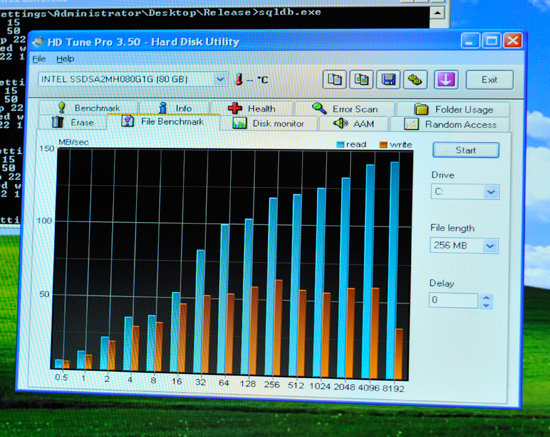The Real Conroe Successor: Clarkdale & All You Need to Know about Westmere
by Anand Lal Shimpi on September 24, 2009 6:00 PM EST- Posted in
- CPUs
AES-NI
Westmere does add some new instructions to x86, although the big expansion comes with AVX and Sandy Bridge next year. Westmere gets six new encryption/decryption instructions. The group of instructions accelerate AES (Advanced Encryption Standard) and are thus referred to as AES-NI.
All the new instructions need is software support and you'll see acceleration on Westmere. There were Winzip demos aplenty, which will have full acceleration support when the first Westmere chips hit.
When accelerated, Intel believes there will be no performance hit for encryption/decryption and it had the demos to back it up.
Here we're looking at disk throughput of an Intel SSD with full disk encryption enabled. Without AES-NI the performance takes a real hit:

40MB/s reads, 20 - 30MB/s writes
But with it, you can hardly tell you're even running AES:

~150MB/s reads, 50MB/s+ writes
Intel expects that full disk encryption and improved security will be commonplace once Westmere is in the mainstream.










96 Comments
View All Comments
Wolfpup - Friday, October 16, 2009 - link
Dual core CPUs in 2010, AFTER we've had quad core for three generations, and even have a fairly reasonably priced Core i7 in NOTEBOOKS now? Boooooring!cosminliteanu - Wednesday, September 30, 2009 - link
Hi,anybody know when Intel will add support for USB 3 and SATA 6 GB? And most important in which chipset/platform will be ?
Thanks.
NeBlackCat - Tuesday, September 29, 2009 - link
Once again AMD will be getting my money as I'm not being forced to buy two motherboards to get the CPU that I want now (Clarkdale) and it's immediate successor.
I'm sure you're gutted.
SFNR1 - Tuesday, September 29, 2009 - link
what PSU was being used?IKeelU - Monday, September 28, 2009 - link
I hope that mini-ITX is < 100$. I'll finally be able to upgrade from my existing atom board and its measly 2 SATA ports.cjs150 - Tuesday, September 29, 2009 - link
Exactly. Personally I am excited by this. I need to build a couple of things for the home network1. HTPC - this needs to be very very quiet. This new CPU and Mini ITX board looks spot on if (and it is a big if) Intel actually delivers on HD acceleration for both video and audio
2. Small home server to replace the ancient thing currently flogging its guts out. This looks close - low power is good but I have two big requirements. (a) standard PCI slot for my RAID card which is an 8 port SATA raid card (Broadcomm) which just works exactly as it should. (b) with all the HD streams 2 xGb ethernet ports would be nice to allow for future expansion (and yes I know it is overkill). Looks like the current minim-itx board fails on both
CrimsonFury - Thursday, October 8, 2009 - link
An 8 port SATA controller is very limited via standard PCI.Even a PCI-E x1 slot would double the bandwidth (x4 or or x8 would be better)
Just use one of the mini-ITX boards that has a PCI-E x16 slot and check a PCI-E sata controller in there.
Holy Smoke - Saturday, September 26, 2009 - link
Am I the only one who finds the tock-tick thingy retarded?It's the wrong sequence, dammit! It's like an army going 3-4-1-2 fer chrissakes!
2good2btrue - Monday, September 28, 2009 - link
Okay, how is this the wrong sequence?They optimize the circuit design, from a known good/working design, then they optimize it at the smallest current size possible.
How is this retarded?
strikeback03 - Monday, September 28, 2009 - link
I'd guess he is arguing that the tick should be the new microarchitecture, and the tock should be the shrink of that.